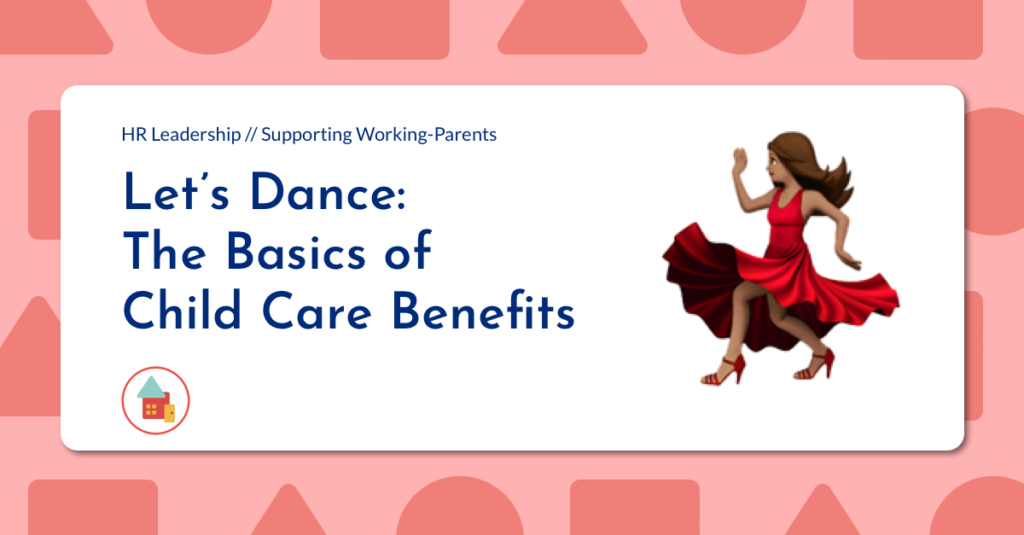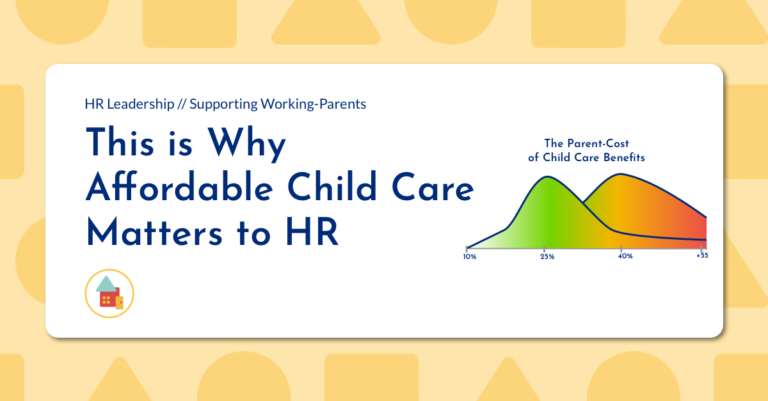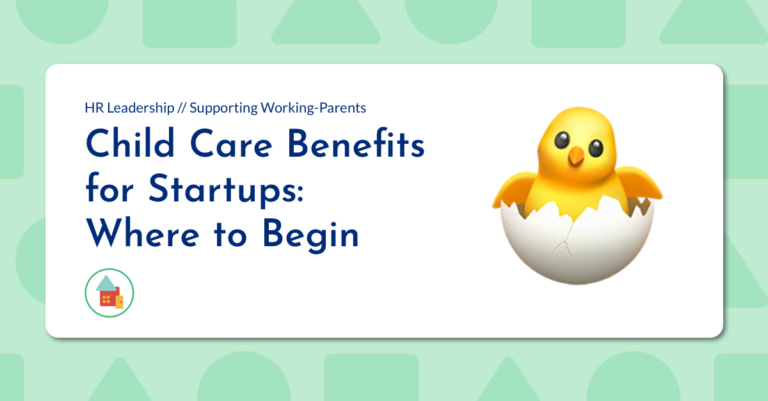In my last post we covered three fundamental questions that HR leaders need to consider before evaluating child care benefits. Namely, when and where do your working-parents actually need child care, and how much can they afford to pay for it? If you don’t have a grasp on those three details, I recommend going back and starting there.
Alright, you’re still here, so I’ll assume you’re warmed up and ready to get into it. Let’s SALSA!

Seriously, what’s with the corny acronyms? 🤣 Well, research shows that acronyms help us better understand new concepts, and child care is a new priority right now, so play along while we unpack these five key aspects of full-time child care options: Safety, Age-ranges, Locations, Size, and Affordability. Once you’ve got the basics of SALSA we’ll be ready to talk about the right size and type of solutions for your organization.
SALSA: 5 Keys to Child Care, 1 Corny Easy-to-Remember Acronym
Safety
The health and safety of your employee’s children always comes first. As HR leaders, we stand behind the services and vendors we present to your employees. Entrusting a caregiver with an infant child is one of the hardest choices an employee will have to make in their first few months as new parents. So you want to do your research and be confident that you’re recommending professionals that you’d trust if these children were your own.
Here’s where licensing and regulations come in. Every state has a licensing body that regulates, licenses, and monitors child care that takes place in home daycares and child care centers. For example, in Massachusetts, the Department of Early Education and Care licenses about 8,000 programs and conducts annual inspections for each. This means that these programs must meet state guidelines on caregiver experience, facility safety, and passed a 3-part background record check including fingerprinting checked against the federal database. On the other hand, nannies, au pairs, babysitters, and tutoring services are not regulated and are not licensed or monitored by the state. Now, that doesn’t mean these are not safe options, it simply means that as an employer you’ll want to understand how service providers verify the qualifications, experience, and safety records of caregivers they employ or refer.
This goes for any employer, but consider for a moment the example of Boston Children’s Hospital. As the preeminent pediatric hospital in the world, their doctors, nurses, and admin staff expect the best. So, when they evaluate child care benefits, quality and safety are their very first requirements. (Spoiler alert: Children’s takes a “portfolio approach” to child care, working with multiple services to weave together a suite of benefits that fits the needs of their workforce. I’ll share more details on this in my next post.)
Age-Ranges
When you think about child care, what springs to mind? Finger painting? Reading circles? Kids running around the playground? Totally fair, and adorable, but those imaginary children are probably 2-4 years old, and in reality your parental leave is probably closer to 2-4 months. If you expect your best people to return from parental leave at full force, don’t leave them to “piece it together” on child care.
This is also where gender equity comes in. Even today, in most households the mom shoulders the majority of child care responsibilities. Despite the progress we’ve made in the last generation, a startling 57% of women leave the workforce with the birth of their first child. Many plan to only do so temporarily but find it harder than anticipated to return at all, much less on par with their pre-child career trajectory.
To help new parents, especially women, successfully return to work, employers need to help them find full-time infant care. Because of the demands of caring for infants and ratio requirements, infant care is both harder to find and and more expensive than child care for children ages 3 and up. Generally, large centers cater to children starting at 33 months, where regulations allow them to combine up to 20 children in a single room in an effort to keep costs down. Many have a limited number of smaller rooms for toddlers, and either no or very few spots for infants.
At the infant level, if parents are going to go back to work full time, most go with either a nanny or a home daycare. A small minority of high-income families may consider hiring a nanny, but given the exorbitant cost of 1:1 care, most families will look for a home daycare. These small-scale programs are licensed by the state and typically reserve two spots for children under 12 months.
Locations
So where do your working-parents live? Do they drive to work or take public transportation? Are they living in dense urban areas, or suburban / rural areas?
In any case, the dream for most parents is to find child care that’s right in the neighborhood. During normal times, this proximity makes drop-offs and pick-ups easier. If they live in the city they can pick up on the walk home. In the suburbs or rural towns, the shorter the drive, each way, the better. For parents with a commute of any length, tacking onto it to drive to and from child care in an inconvenient location adds unnecessary stress to their already full days.
The child care options available to your employees changes with the landscape. Home daycares are generally not found in dense downtown areas, but rather start to appear in inner suburbs and stretch all the way out to more rural towns. For example, there are over 2,000 home daycares within a 20 mile radius of downtown Boston, and then another 3,000 dispersed throughout the remainder of the state,
Size
Child care comes in all shapes and sizes. If you’ve ever seen big YMCA or Kindercare, they look a lot like elementary schools and operate similarly. Children are assigned to classrooms grouped by age. At the other extreme would be a nanny, who watches a child 1:1 in the parents’ home. While child care has proven remarkably safe since reopening from Covid, the rule of thumb right now is simple: smaller is better.
This is the second big reason that more parents are increasingly seeking out home daycares. While home daycares share the benefits of safety and professionalism that come from being regulated and licensed by the state, they are much, much smaller than center-based programs. These small-scale programs are hosted in the home of the caregiver and serve just 6-10 children every day. In addition to having fewer people around each day, these smaller programs also support more individualized attention and children benefit from greater continuity of care, as they will work with the same provider for multiple years.
One of the paradoxes in child care is the relationship between the size of the program and the cost of the program. For that, we need to think about two main factors: ratios and facilities. Nannies are almost always going to be the most expensive option because of the 1:1 ratio: the parents have to cover the entire salary of the caregiver. At the other end of the spectrum though, center-based care is particularly expensive because of the cost of the facilities and the multiple levels of administration staff. Home daycare avoids both of these pitfalls by operating out of the caregiver’s home and splitting the cost of the caregiver’s amongst 5-6 families. Which leads us to the importance of affordability.
Affordability
Recently it seems like every news headline tries to come up with an even more creative way to tell us what we already know: that child care is really expensive. No many how many times we hear that “child care costs more than college” or “the cost of childcare has doubled in the last 12 minutes,” it doesn’t change the fact that your working-parents need child care. As an HR leader, you’re probably not going to focus your efforts on the national debate about how to reduce the cost of childcare. But you also can’t ignore the affordability issue when considering child care benefits for your team.
This is where “benefit equity” comes in. Remember, equity ≠ equality. For example, a corporate program with a nanny-placement agency may unintentionally favor your high-earners and leave out lower-earning employees. Because even if it’s made available to all your employees, what percentage of them are able to afford a nanny, regardless of the placement fee? Benefit equity considers each income-tier and what types of supports they need to be productive at work. You wouldn’t not consider a public-transit benefit just because “only 40% of the team commutes via the T!”
An important note here: a focus on affordability is not the same as sacrificing quality. Remember our example of Boston Children’s Hospital – if the hospital is not clean, the surgeons can’t operate – it’s a whole-team effort, and their HR leaders have found child care benefits that supports every division within the organization (again, more on that next post).
If you expect your best people to return from parental leave at full force, don’t leave them to “piece it together” on child care.
Taken together, by considering Safety, Age-range, Location, Size, and Affordability we can start to get a sense of what are the unique needs and priorities of your workforce. For instance, if you have 15K FTE and need people to report to a hospital, you’re going to want to prioritize full-time care with flexible hours, starting at the infant level. If you are a manufacturer with 2K FTE in a rural area, you’ll need to take stock of what child care options are available in your area.
In any case, the next step as a HR leader is to decide where to start: are you building a portfolio that will address the needs of most of your working parents? Or are you just getting started and looking to make your first investment specifically in response to Covid-19? What does the portfolio approach look like? More on that in my next post.
Looking for help assessing your current situation and child care needs? Request a call to discuss the SALSA framework with a child care benefits expert.




